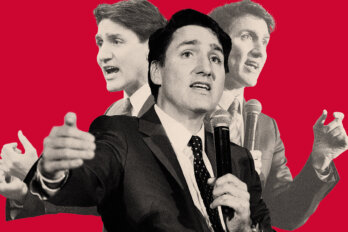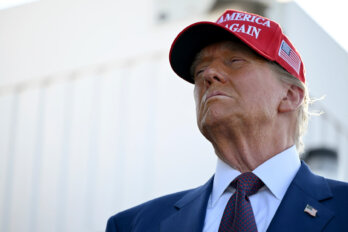On January 23, when federal judge Richard Mosley ruled that Prime Minister Justin Trudeau and his cabinet had overstepped their authority by invoking the Emergencies Act, I thought back to that terrible February when “angry fringe groups” sparked a national debate over how elected authorities should deal with widespread civil disobedience. I’m speaking, of course, of the Wet’suwet’en protests.
The “angry fringe” quote came from Jason Kenney, Alberta’s then premier, in 2020, two years before Trudeau used almost the exact same words to describe the “Freedom Convoy,” which had driven trucks and vehicles to occupy downtown Ottawa. The Coastal GasLink pipeline was being built through the heart of the Wet’suwet’en First Nation’s territory in central British Columbia, against the will of some of their hereditary chiefs. Tensions had been building for over a year; then the RCMP raided one of the Wet’suwet’en blockades on a remote access road, and images of peaceful Indigenous protesters being dragged off their land to make way for a pipeline were beamed across the world. Within hours, solidarity blockades began to spread across the country. Trucks and trains were blocked at Canada’s four largest ports—Vancouver, Montreal, Prince Rupert, and Halifax—and rail traffic was halted or disrupted in seven provinces. As the month wore on, then transport minister Marc Garneau voiced concerns that cities would soon run out of water-treatment chemicals and other critical supplies.
The prime minister and his cabinet initially tried to negotiate a peaceful resolution, despite intense pressure from Conservative leaders to use force. “We are not the kind of country where politicians get to tell the police what to do in operational matters,” Trudeau said.
Then Conservative leader Andrew Scheer later asked, “Will our country be one of the rule of law, or will our country be one of the rule of the mob?”
On February 21, after two weeks of fruitless discussion, Trudeau declared that dialogue with Indigenous leaders had failed and that “the barricades must now come down.” He insisted he wasn’t telling the police what to do. Nevertheless, police units began ramping up their enforcement of court injunctions to dismantle the blockades. They received help from the soon-to-be-declared COVID-19 pandemic, which was starting to spread as fast as the protests at that point. Come March, the pipeline was largely forgotten, as were concerns over nationwide occupation protests—until February 2022, exactly two years later.
In retrospect, it seems clear that one of the big cultural shifts the pandemic brought about was an awakening to the powers of mass protest among the right wing. Before lockdowns and vaccines, modern public demonstrations in North America (and their edgy cousin, civil disobedience) were primarily the domain of the left, inherited from the civil rights era: Occupy Wall Street; Idle No More; Black Lives Matter; the climate marches led by Greta Thunberg, who, just four months before the Wet’suwet’en blockades, headlined a global climate strike that brought millions of people into the streets of hundreds of cities around the world. Even a year into the pandemic, the combined causes of Indigenous rights and environmental protection were potent enough to spark one of the biggest acts of civil disobedience in Canadian history—at Fairy Creek, on Vancouver Island, where over 1,000 anti–old growth logging protesters were arrested in the summer and fall of 2021.
Old growth forests are still being logged in BC. Canada’s production of oil and gas, like the world’s, is still going up. So are greenhouse gas emissions. The Coastal GasLink pipeline was completed last November.
Contrast that with the results achieved by the Freedom Convoy in February 2022. Most obviously, the Canada flag–draped semi-trucks seized attention like no other protest ever has in this country. I recall envious chatter amongst the activist community at the time—people who repudiated the convoy’s politics but respected how brazenly they’d hijacked the national conversation. The Freedom Convoy drew sympathy from the Conservative Party, effectively becoming their new base at both the national and provincial levels. A direct line can be drawn between the occupation of Ottawa and the rise of Pierre Poilievre to leader of the federal opposition (and possibly to the Prime Minister’s Office next). The convoy can also take some credit for the election of Danielle Smith as premier of Alberta; like Poilievre, Smith has showered their cause with praise, calling unvaccinated people “the most discriminated-against group that I’ve ever witnessed in my lifetime” at a news conference following her swearing-in ceremony.
Now that vaccine passports and other pandemic restrictions have faded away, the freedom crowd’s promotion of oil and gas has returned to the fore (don’t forget, the convoy’s first iteration was the pro-pipeline, anti–carbon tax “United We Roll” protest of 2019). Poilievre, who invokes freedom at every rally, has promised to “support pipelines south, north, east, west.” Smith put a “pause” on all renewable-energy projects in Alberta; recently, she also joined Tucker Carlson, one of the Freedom Convoy’s biggest American boosters, on stage in Calgary. In light of all this, it seems fair to ask: Did the right beat the left at its own game?
In his ruling on national emergencies, Judge Mosley wrote: “At the outset of these proceedings, I was leaning to the view that the decision to invoke the [Emergencies Act] was reasonable. I considered the events that occurred in Ottawa and other locations in January and February 2022 went beyond legitimate protest and reflected an unacceptable breakdown of public order. I had and continue to have considerable sympathy for those in government who were confronted with this situation. Had I been at their tables at that time, I may have agreed that it was necessary to invoke the Act.”
That’s a remarkable statement for a federal judge to put on paper. As legal commentator Stephen Lautens noted on social media, it’s unusual for a judgment to contain admissions of personal bias. This one was studded with self-reflection.
Mosley’s initial “leaning” was reversed, he wrote, by close inspection of the Emergencies Act itself. He made clear that there were two elements in particular he disagreed with: first, the narrow definition of “threats to national security,” which currently excludes economic considerations (such as Transport Canada’s estimate that the border blockades cost $3.9 billion in lost trade). “I am unable to find that the term encompasses the type of economic disruption that resulted from the border crossing blockades, troubling as they were,” Mosley wrote, suggesting “it may be that parliament will want to revisit” the act’s definition. Alas, he added, “This Court can only apply the law as it finds it.”
Mosley’s second complaint was related to the core indictment of his decision—namely, that Trudeau and his cabinet overstepped their authority. The Emergencies Act, Mosley found, explicitly forbids the federal government from seizing powers the provinces already have. That prohibition was why the federal government never declared a national emergency in response to the pandemic itself and instead left it to the provinces and territories to declare their own states of emergency. But in February of 2022, provincial authorities—especially in Ontario—declined to use their policing powers to remove protesters and their trucks from the nation’s capital. That refusal by the province to act was the emergency, as the federal government argued in its defence.
Mosley agreed but once again found that the Emergencies Act doesn’t contemplate provincial revolt: “It may be considered unrealistic to expect the Federal Government to wait when the country is ‘threatened by serious and dangerous situations,’ as the Respondent characterizes the events of January and February 2022, while the Provinces or Territories determine whether they have the capacity or authority to deal with the threat . . .” he wrote. “However, that is what the Emergencies Act appears to require.”
Mosley even took the step of inviting an appeals court to overturn his conclusion: “I may err on the findings I make in these reasons. However, such errors can be cured on appellate review.” To be fair to Mosley, he’s not the first judge to express uncertainty on this file. Justice Paul S. Rouleau, who chaired last year’s public inquiry into the matter and reached the opposite conclusion (that Ottawa did have cause to invoke the Emergencies Act), likewise wrote that “reasonable and informed people could reach a different conclusion than the one I have arrived at.”
It’s easy to mock these expressions of ambivalence, even at our highest court. But maybe we should acknowledge the honesty that underpins them. Maybe it’s worth pausing to consider the questions they pose about this unprecedented era, so full of new problems and outdated solutions.
Since Parliament passed the Emergencies Act in 1988, “the threats to Canada that constitute public order emergencies have evolved,” Justice Rouleau wrote in his report. He quoted Wesley Wark, a senior fellow at the Centre for International Governance Innovation, who testified before the inquiry that national security and intelligence organizations have failed to keep up with “new challenges,” including “foreign interference, the malicious spread of disinformation, rampant espionage, cyber threats, and the undermining of Canadian economic security. Democracy itself is being challenged by a new threat environment in which authoritarian movements are on the rise globally and anti-government conspiracy theories flourish across the internet. Transnational threats to security posed by pandemics and climate change impacts are imposing increasingly stiff costs domestically and internationally.”
Rouleau’s report included fifty-six recommendations. Most pertained to improving coordination between various levels of police and government, but a handful focused on updating the Emergencies Act itself; above all, Rouleau concluded the federal government should update the act’s definition of threat to national security. But he also stressed that “the safeguards contained in the current Emergencies Act should not be weakened.” Canadians must beware of any revisions which “unreasonably interfere with or suppress protests that are an important part of our democracy.”
A government’s power to quell an emergency, in other words, always runs the risk of becoming its own emergency. How should we balance those dangers? That’s the dilemma Rouleau and Mosley both wrestled with. A court of appeal will wrestle with it next—and perhaps, after that, the Supreme Court too. For its part, the federal government appears to be waiting for a final judgment before attempting to answer that question.
The thing about dilemmas is there are no right answers. For now, at least, the best outcome for Canadians may be to have the right people keep asking the right questions.
With thanks to the Trottier Foundation for helping The Walrus publish writing on climate change and the environment.





